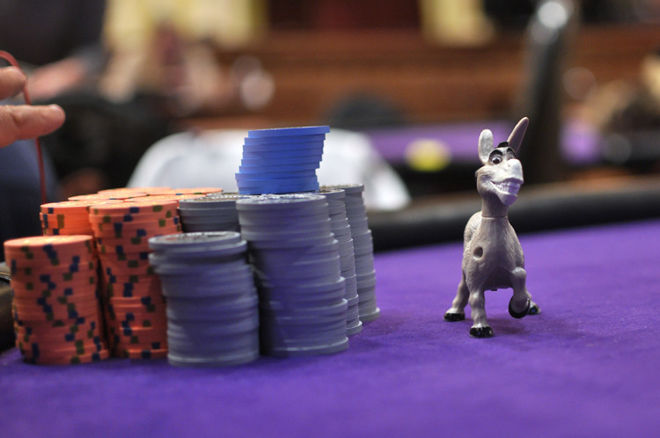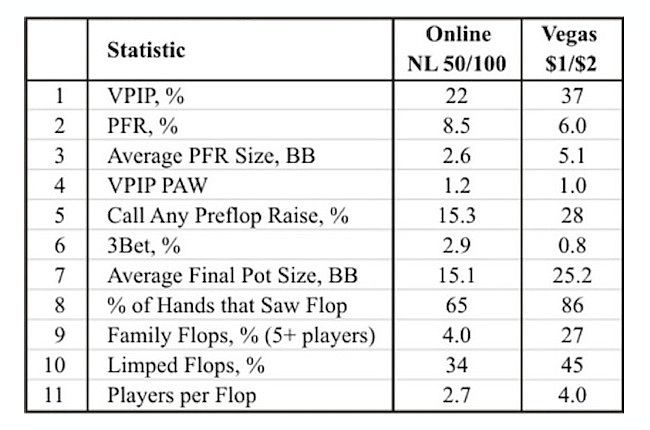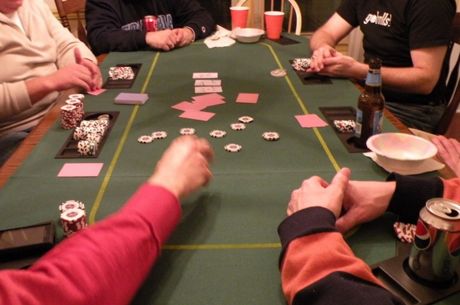Donkey Poker: Low-Stakes Live Games Differ from Online

My Donkey Poker books aim to teach players how to crush the low stakes no-limit hold'em games commonly found in Las Vegas. I define a "Donkey Game" as the typical $1/$2 or $1/$3 Vegas game, and often the $2/$5 games found there. The term also applies to many other card rooms around the world, especially for their smallest games.
The key aspect of a Donkey Game is that it is populated mostly with "Donkeys." But to be clear, I don't consider a Donkey to be just a bad player. Rather, I define such a player somewhat differently.
A Donkey is a relatively experienced player who does not adapt to his opponents. He is poker-stubborn, like a donkey. He is typically extremely loose and somewhat passive. If he likes his hand, he will play it from any position, whether the pot has been raised or not. He is a first-level thinker preflop, and often postflop. This makes him extremely exploitable.
An "optimal" Donkey Game strategy actually has many concepts in common with tougher online games or higher stakes live games. That means if you are a winning online player, you also should be able to beat Donkey Games. But you will probably not crush them unless you adapt to their idiosyncrasies.
Live Games Are Not Like Online Games
Most of my initial poker experience was online. In fact, my first book, The Statistics of Poker, was entirely about online no-limit hold'em data mining and statistical optimization.
But when I moved to Las Vegas and tried to apply my solid online poker strategies to the live $1/$2 and $2/$5 games, I was not as successful as I expected to be. "Damn!" I'd say to myself. "These guys just won't fold. They are terrible. I'd rather play better players." Perhaps you have heard similar complaints from "solid" players.
But the problem isn't with the Donkeys �� it's with us. No poker strategy works well against every opponent. It's crazy to think we should do better playing against strong players rather than weak ones. The fact is, the strategies we have developed against relatively strong online NL200 players will not be ideal against Vegas $1/$2 players. We must adapt.
Live Playing Stats
Online playing stats are easy to obtain. We can gather them as we play by using database programs like PokerTracker. Or we can purchase millions of hand histories and import them into such a program, which is what I did when writing The Statistics of Poker.
We can use these stats to detect and minimize our own leaks. We can also use a Heads-Up Display (HUD) to see our opponents' stats, allowing us to exploit them.
But compiling live-game stats isn't nearly as easy. We usually have to gather them ourselves using painstaking note-taking. Consider the table shown below, which summarizes some key stats for online NL50/NL100 and compares them to live $1/$2 NLH games in Las Vegas. We can see at a glance that the Vegas games play much differently than playing poker online.

Let's consider just a few key ways that Vegas Donkey Games are different.
VPIP: Donkeys Are Very Loose
The average online player has a VPIP (Voluntarily Put $ In Pot) of about 22 percent (Row 1). Although this online VPIP is too loose, the average Vegas $1/$2 player has a VPIP of 37 percent �� almost 70 percent looser, comparatively speaking.
This extra looseness is a key reason Donkey Games are so easy to beat. They play too many hands and they must find a way to shed them postflop when they miss. Or they marginally hit and don't fold until they have lost even more chips. Their preflop looseness is like building a pyramid on top of sand rather than bedrock.
PFR: Donkeys Are Passive
Another major difference is preflop aggression. The average online player has a PFR (Preflop Raising) of 8.5 percent (Row 2), which is already lower than optimal. But the average Vegas $1/$2 PFR is only 6 percent. This extra passivity is actually somewhat understandable when we consider that the average size of a preflop raise is much higher in Vegas (Row 3).
Most Donkey Gamers have concluded that raising preflop doesn't pay. They raise to 5 BBs and still get called by too many villains. ("These guys just won't fold.") Row 5 shows that Donkey Gamers call preflop raises nearly twice as often as online players. So if doubling the raise size nevertheless results in twice as many callers, it's not surprising that Donkey Gamers don't like to raise without a premium hand.
Another indication of passivity is their preflop three-betting percentage (Row 6). The average online player three-bets more than three times as often as the average Vegas $1/$2 player. This reluctance to three-bet probably comes from the same rationale that makes them reluctant to raise in the first place.
Note that a 0.8 percent three-betting range means reraising with only a very tiny range �� even less than {KK+}. This makes the typical three-bet a very transparent action. Once we have identified a player as generally passive, his three-bet should be a loud warning bell.
PAW: Donkeys Are Not Position Aware
Row 4 shows the position awareness stat ("PAW"). VPIP PAW is simply VPIP from late position divided by VPIP from early position (VPIP-LP / VPIP-EP). In other words, this is just a measure comparing how many hands we play from late position (hijack, cutoff) compared to how many we play from early position (under the gun, UTG+1).
The average player on online poker sites plays about 20 percent more often from late position than from early position, which is only slightly position-aware. But the average Vegas player is even worse, playing the same number of hand regardless of position. The typical Donkey Gamer plays his hand if he likes it, with little regard for his position. He is position-dumb.
Donkey Game Dynamics
We can also see that in Vegas games final pot sizes are much larger (Row 7), there are many more "family pots" (Row 9), and more players see an average flop (Row 11) �� all of which confirms that game dynamics should be different for Donkey Games. Perhaps limping is going to be more acceptable, since we are less likely to be raised off of hands, and since we are more likely to get paid off. Perhaps squeezing will be less successful, since Donkey Gamers are much less likely to fold.
We will explore these concepts (and others) in future articles.
- Do You Play Too Many Hands?
- Are You a Position-Dummy?
- When Can I Take a Bathroom Break?
- Is Straddling a Good or Bad Play?
- A Preflop Question: Is Limping Lame?
- Maximizing Expectation When Betting For Value
- Maximizing Expectation When Betting as a Bluff
- Five Weak Reasons to Bet (and One Weak Reason Not To)
- Do You Have 'Jack-O-Phobia'? Playing Pocket Jacks in Live NL Hold'em
Steve Selbrede has been playing poker for 20 years and writing about it since 2012. He is the author of five books, The Statistics of Poker, Beat the Donks, Donkey Poker Volume 1: Preflop, Donkey Poker Volume 2: Postflop, and Donkey Poker Volume 3: Hand Reading.
In this Series
- 1 Donkey Poker: Low-Stakes Live Games Differ from Online
- 2 Donkey Poker: Do You Play Too Many Hands?
- 3 Donkey Poker: Are You a Position-Dummy?
- 4 Donkey Poker: When Can I Take a Bathroom Break?
- 5 Is Straddling a Good or Bad Play?
- 6 A Preflop Question: Is Limping Lame?
- 7 Maximizing Expectation When Betting For Value
- 8 Maximizing Expectation When Betting as a Bluff
- 9 Five Weak Reasons to Bet (and One Weak Reason Not To)
- 10 Do You Have 'Jack-O-Phobia'? Playing Pocket Jacks in Live NL Hold'em
- 11 Donk Betting in Small-Stakes Live No-Limit Hold'em









